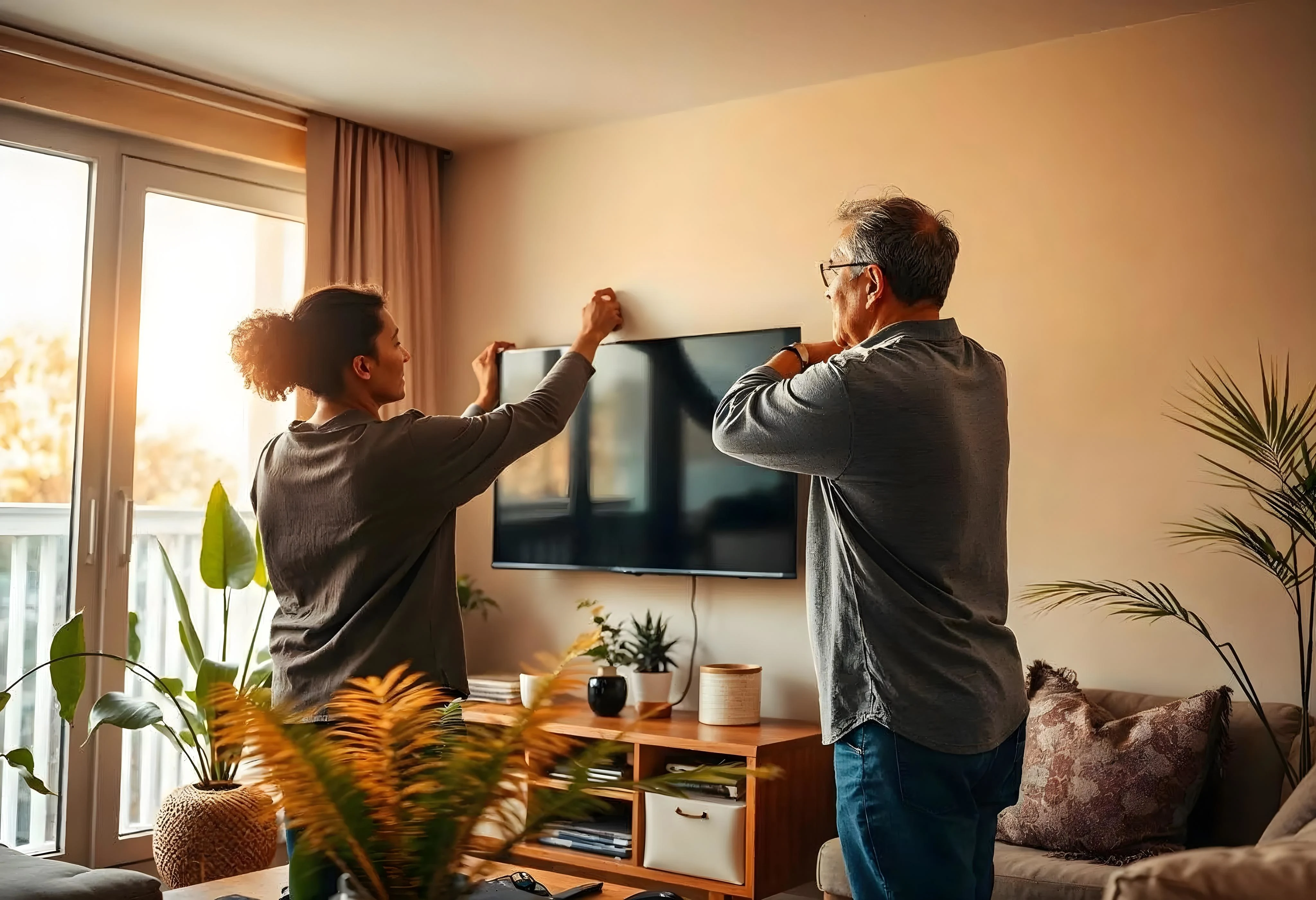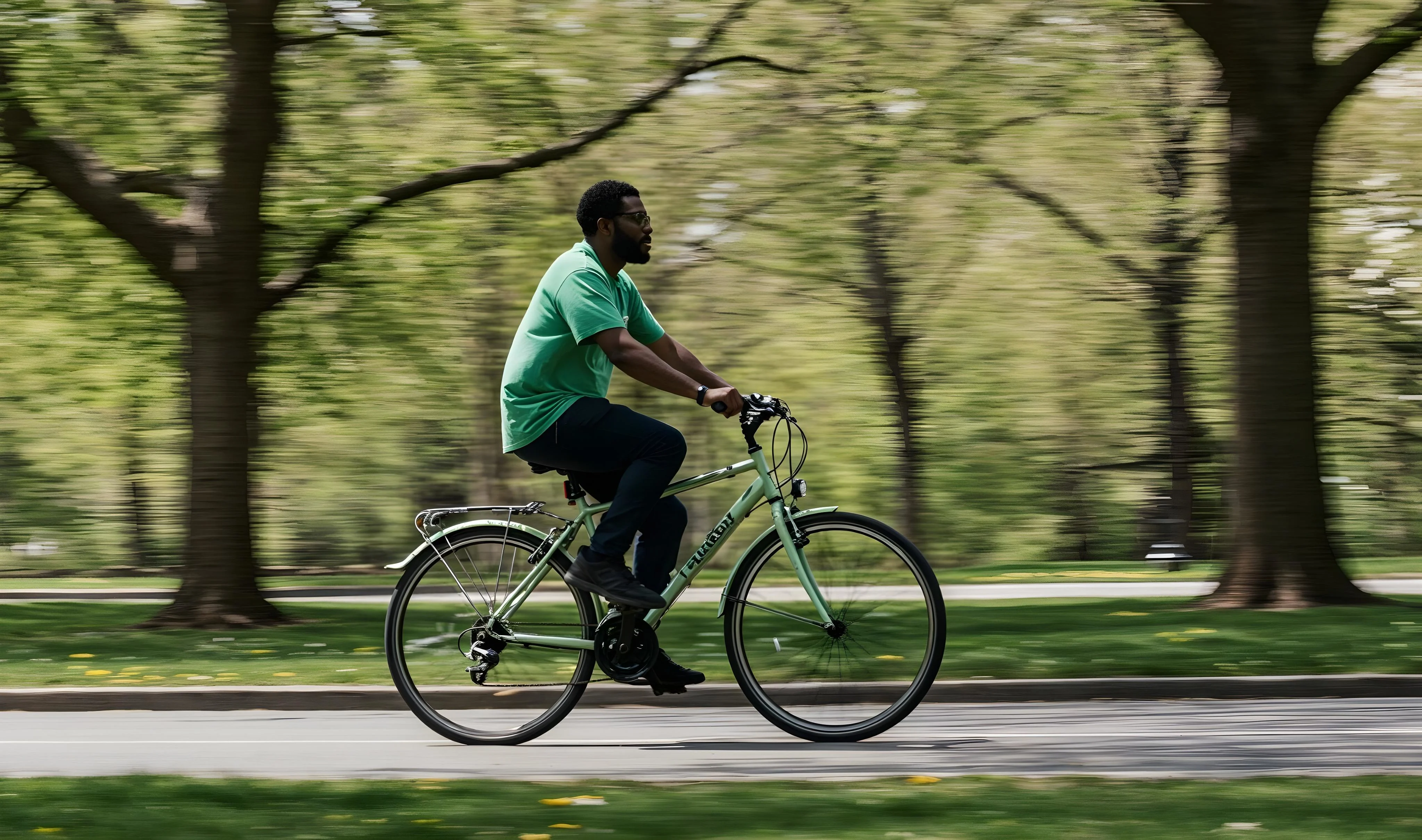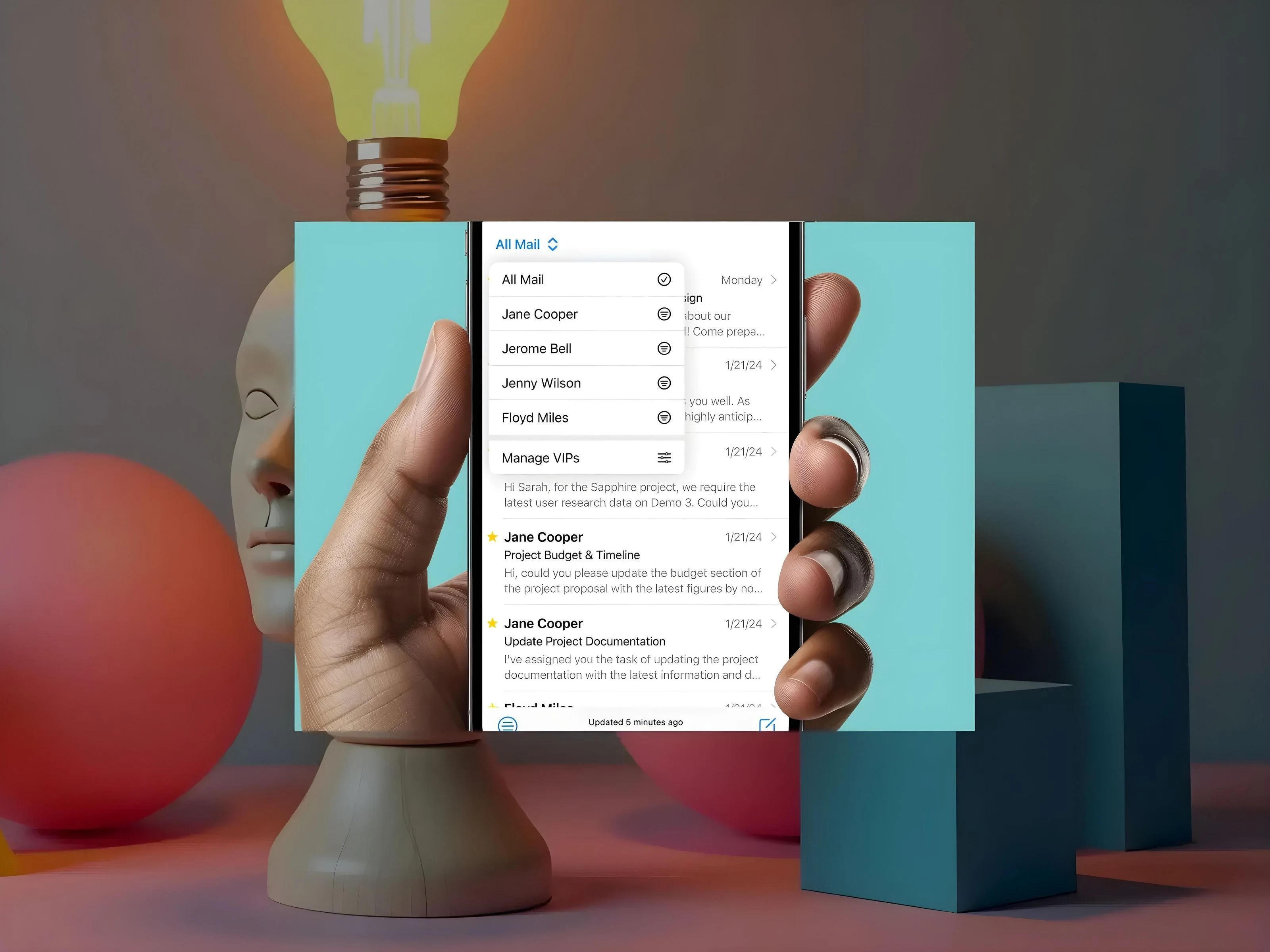Taskrabbit Live Activity
Live Activity: Solving the "Where's My Tasker?" Problem
user base
business impact
role
industry
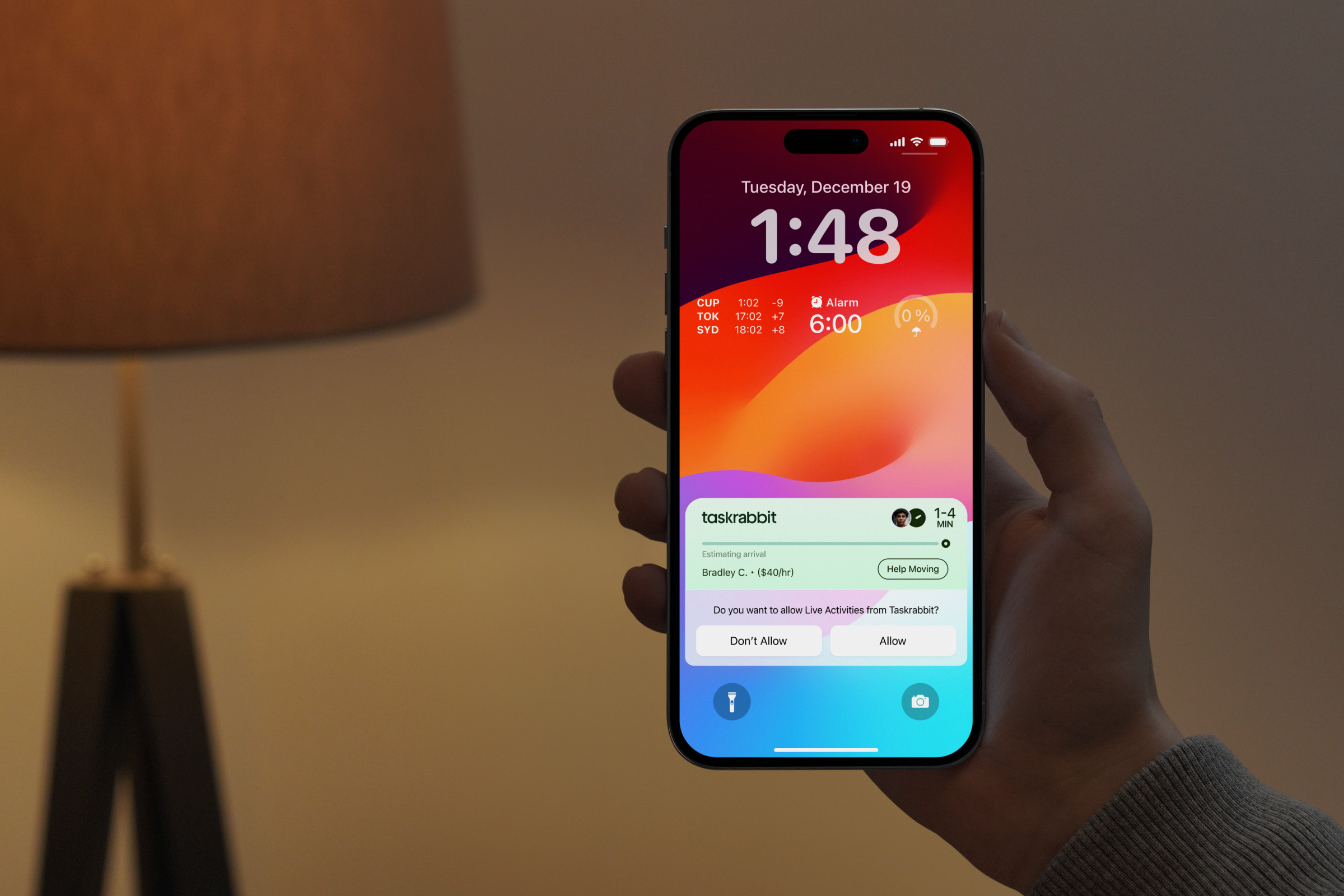
Designing iOS Live Activity to reduce customer anxiety and support inquiries for the app’s thousands of daily tasks.
Taskrabbit is a two-sided marketplace platform founded in 2008 where you can find skilled and trusted local “Taskers” for everything from furniture assembly and mounting to moving and cleaning. Taskrabbit has around 60,000 taskers and is available on iPhones and Androids.
The $3.7B Market Opportunity
In the $3.71B on-demand services market, TaskRabbit was missing a critical feature that competitors like Uber and Lyft had made standard: real-time location tracking. With thousands of daily tasks creating thousands of "Where is my Tasker?" moments, customer anxiety could drive unnecessary support inquiries and impact satisfaction scores.
The Probable Business Reality
• 1.2M+ users experiencing uncertainty during task waiting periods
• Competitive disadvantage against ride-sharing apps that set user expectations
• 89% of iPhone users running iOS 16+ (Live Activities compatible)
The scale of operations - averaging thousands of daily tasks - highlights the volume of user interactions that could benefit from enhanced transparency.
The Current Experience Gap
Dynamic updates display real-time information on the Lock Screen and Dynamic Island, similar to how ride-sharing apps provide live location tracking. While ride-sharing apps have set user expectations for real-time tracking, TaskRabbit's current experience requires users to:
1. Open the app to check status
2. Navigate to messaging to contact Taskers
3. Wait for manual ETA updates
This can create unnecessary friction in an experience that should prioritize convenience and peace of mind. Clients should get real-time updates on their Tasker's location.
Real Customer Pain Point
"I'm eagerly awaiting the arrival of a tasker for an important job. It would give me peace of mind knowing when to expect them or if they are delayed." - Nitesh Chilkuri
The Real Cost
Customer anxiety can create unnecessary friction in an experience designed for convenience, leading to support inquiries and potential churn, and increased app utilization.
learning from the best
Before sketching a single wireframe, I dove deep into how the industry leaders handled this exact problem. Each platform had cracked a different part of the code:
Uber and Lyft taught me about ruthless prioritization. They focused laser-sharp on two things: ETA and vehicle location. Everything else was secondary. Their approach showed me that in constrained spaces, trying to show everything means showing nothing effectively.
DoorDash revealed the power of visual progress. Their order status indicators created a sense of momentum - users could see their food moving through the system. This insight would be crucial for TaskRabbit, where anticipation builds as the Tasker approaches.
Starbucks demonstrated brand consistency at scale. Even in the tiniest interface, their visual language remained unmistakably theirs. This reminded me that TaskRabbit's Live Activity couldn't just be functional - it had to feel like TaskRabbit.
The Design Principles That Emerged
From this research, four non-negotiable principles crystallized:
Glanceable Information
Users needed to understand their Tasker's status within seconds, without fumbling with their phone. This meant prioritizing the most critical details and making them immediately scannable.
Contextual Relevance
Not all information matters at every moment. A Tasker's rating might be important when they're confirmed, but their ETA becomes critical when they're en route.
Visual Hierarchy
With limited real estate, every element needed a clear purpose in the information hierarchy. ETA and Tasker status would dominate, with secondary details playing supporting roles.
Brand Consistency
Even in this constrained space, users needed to feel they were interacting with TaskRabbit, not a generic notification.
Strategy Guides Design
Designing for Live Activity felt like solving a puzzle with half the pieces missing. I had to communicate essential information in a space smaller than a business card - on the Lock Screen and Dynamic Island - while keeping users informed about their Tasker's arrival.
Every pixel mattered, and every decision had to be deliberate. With market and design research completed, I focused on the following strategic questions to guide the design process:
at a glance
Integration
How might we ensure seamless integration of Live Activity into the TaskRabbit app, maintaining consistency with existing design elements?
Information Architecture
How might we prioritize the most critical information within the constraints of Lock Screen and Dynamic Island real estate?
User Experience:
How might we optimize the Live Activity experience to provide clear, actionable real-time updates on Tasker arrival?
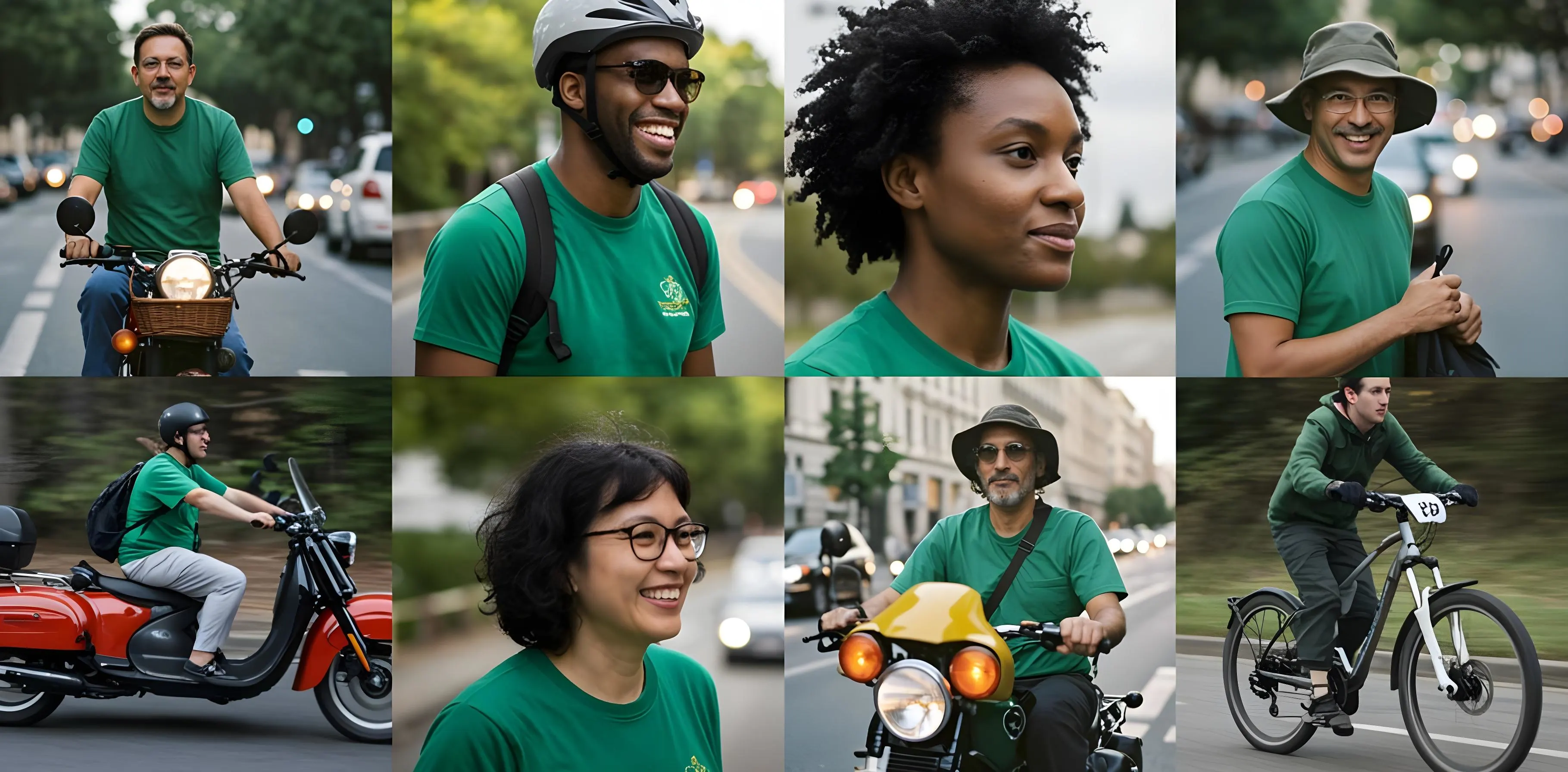
How do I distill the user's service experience into a glanceable update that users can instantly understand without unlocking their phone?
Building the Feature Roadmap
Rather than trying to solve everything at once, I applied the MoSCoW framework to create a clear path from launch to long-term vision. As you may have noticed, I do this every time.
Must-Haves (Core MVP)
•
Tasker "On My Way" trigger when within 60-minute window
•
Real-time ETA calculation based on location data
•
Job title and task type display for context
•
Auto-dismissal when Tasker reaches destination
•
Dynamic Island integration for iPhone 14 Pro+ users
Should-Haves (Enhanced Experience)
•
Tasker photo and rating for trust and context
•
Task pricing information for reference
•
Manual dismissal option for user control
•
Delay notifications when ETA changes significantly
Could-Haves (Future Enhancements)
•
Personalized pre-arrival messages ("Secure any pets...")
•
Task-specific Dynamic Island iconography
Would-Haves (Out of Scope for now)
•
Payment processing integration (’Invoice has been processed’)
•
Task messaging capabilities (one-click action)
The Solution: Peace of Mind
Introducing TaskRabbit Live Activity - an iOS-native feature that transforms customer uncertainty into confidence by providing real-time Tasker location updates directly on the Lock Screen and Dynamic Island, without requiring users to actively check the app.
Core Features Delivered
at a glance
Real-Time Tracking
• ‘On My Way’ trigger when Tasker has begun their route
• Automatic ETA calculations based on live location data
• Dynamic countdown updates as Tasker approaches
Glanceable Information
• Lock Screen integration showing essential details at a glance
• Dynamic Island support for iPhone 14 Pro+ users
• Task context (job title, pricing, Tasker rating) without app opening
Smart State Management
• Automatic progression: ‘On My Way’ → ‘Nearby’ → ‘Arrived’
• Delay notifications when ETA changes significantly
• Push notification when Tasker is 5 minutes away
design deliverables
Allowing Live Activities
Live Activity permission prompt displaying the real-time task tracking interface. Users are prompted to allow Live Activities, enabling them to receive continuous updates about their Tasker's location and estimated arrival time directly on their lock screen.
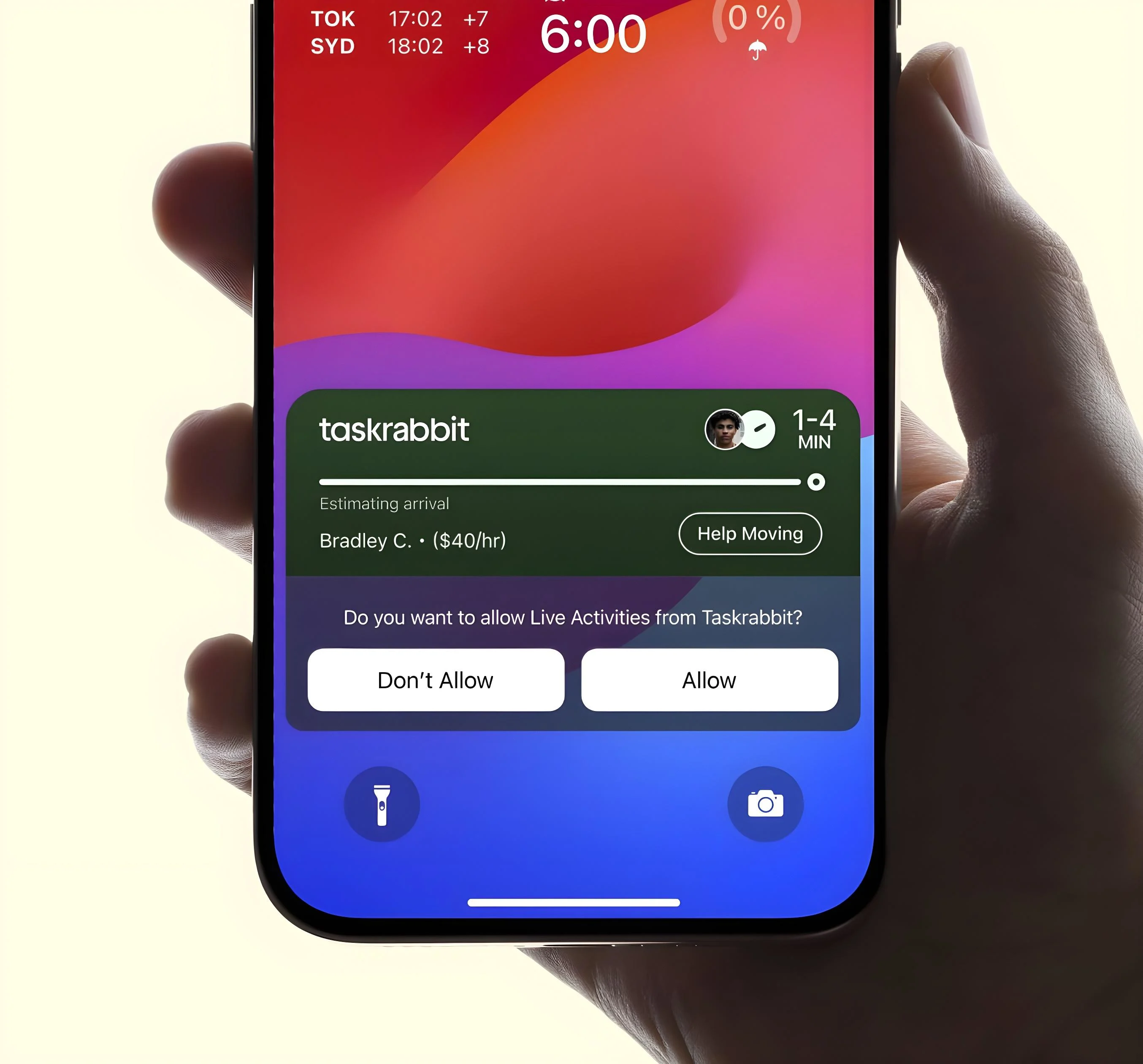
Check-in with Chat
In-app integration is how Live Activity connects with the existing chat functionality. The Taskrabbit Assistant prompts the Tasker to check in and start sharing their location, which then triggers the Live Activity feature. It's this handoff between chat and Live Activity that allows the users to track their Tasker's progress.
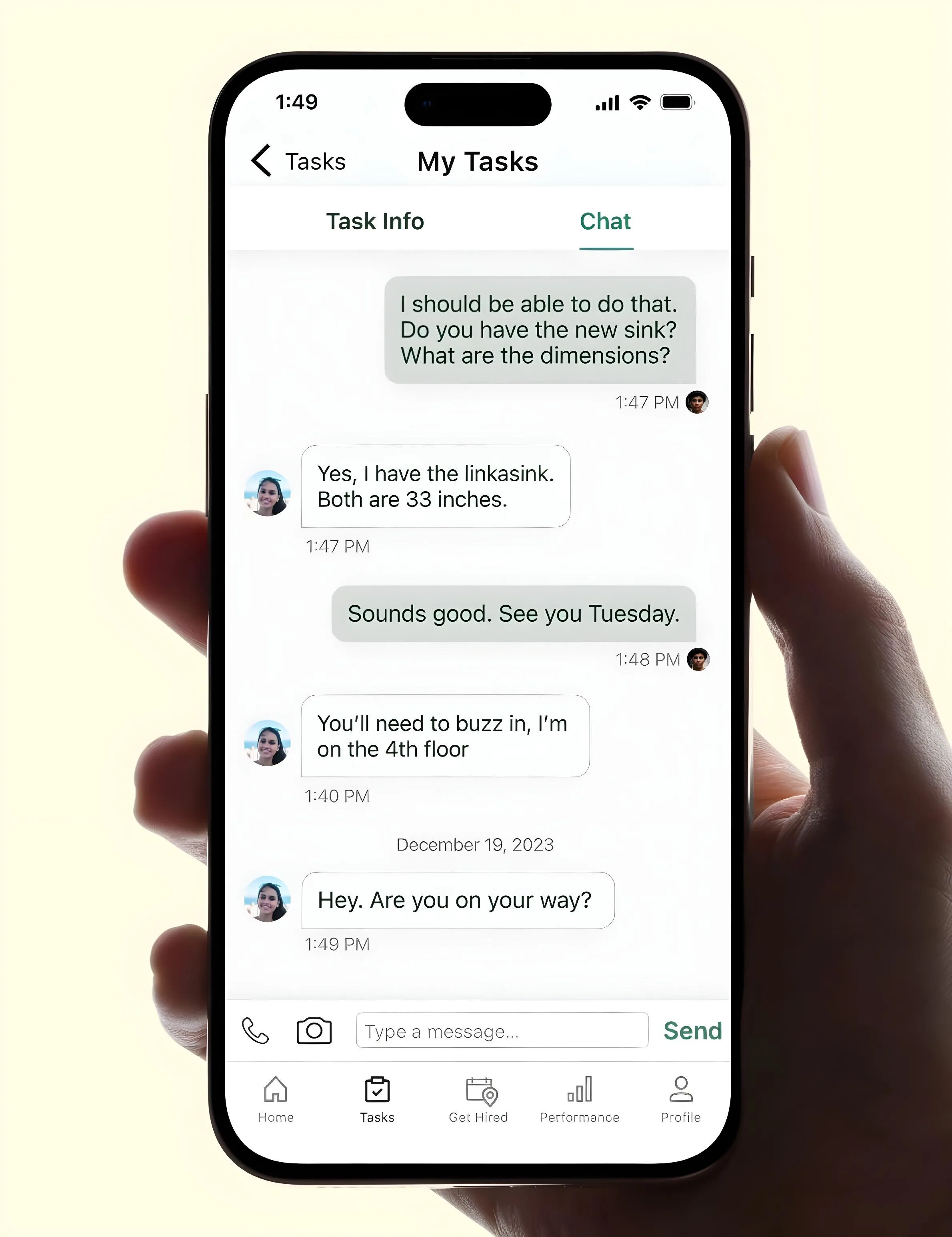
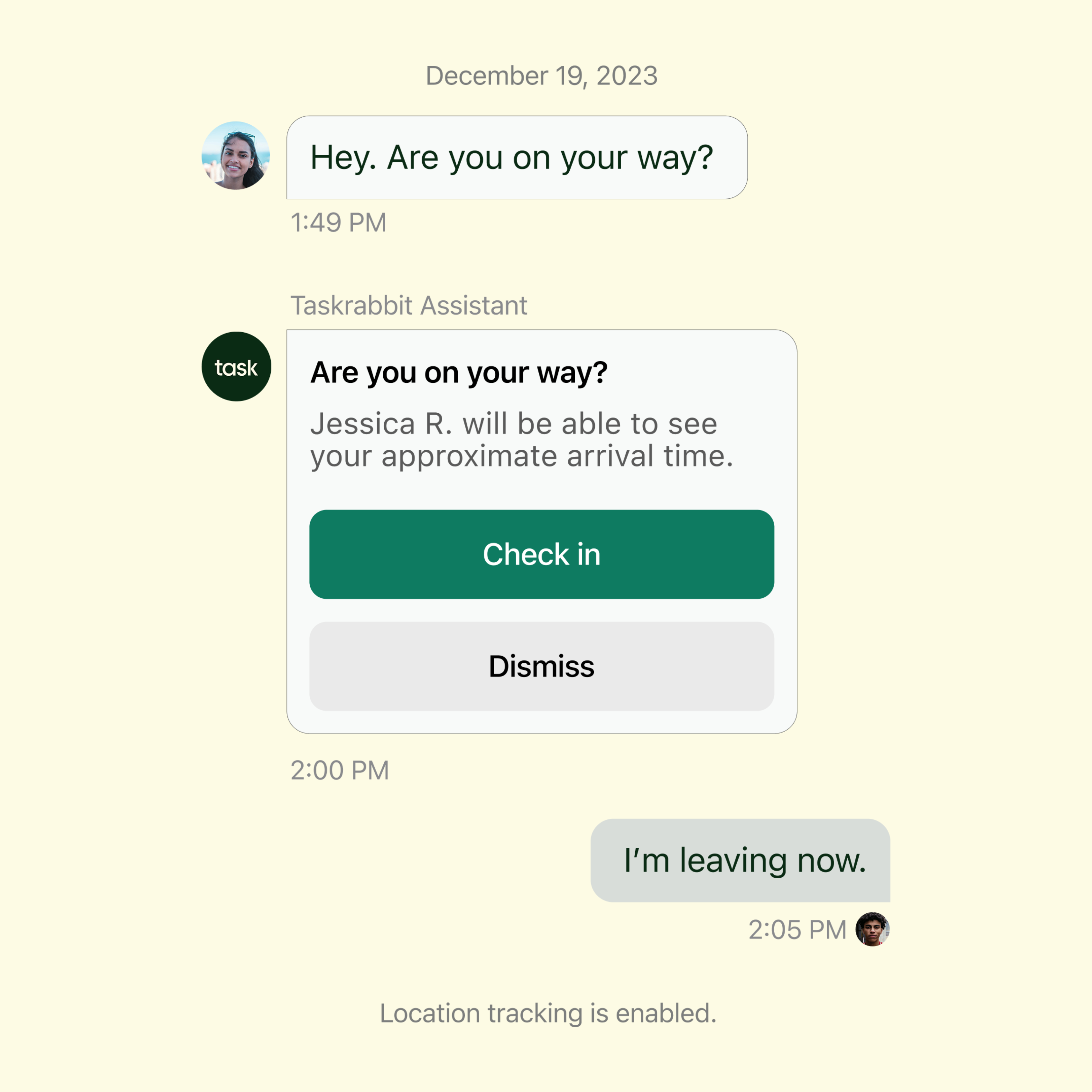
Major Design Evolution
The final Live Activity design represents a significant evolution from initial concepts. Through iterative refinement and user feedback, several key design decisions emerged that elevated both the visual appeal and functional clarity of the experience:
Real-Time Tracking
• Earlier: Solid black background with sharp edges that mimicked Dynamic Island
• Final: Light translucent background with rounded corners and subtle transparency effects
• This creates a more elegant, glass-like appearance that feels less intrusive
Real-Time Tracking
• Earlier: Heavy black bar that dominated the screen
• Final: Lighter, more ethereal presence that floats gracefully over the wallpaper
• The translucency allows the beautiful gradient background to show through
Information Hierarchy Improvements
•
Earlier: All text in white on black, creating high contrast but heavy visual weight
•
Final: Softer contrast with the translucent background, making it easier on the eyes
•
Better integration with iOS's overall design language
Notification Integration
•
Earlier: Separate notification bubbles appeared alongside the main interface
•
Final: Clean integration where notifications and Live Activities work together seamlessly
Status Messaging Refinement
•
You maintained the key information (Bradley C., $40/hr, arrival times)
•
But refined the status messages ("Departing now," "On the way," "Arriving soon," "Estimating arrival")
•
The progress bar and timing feel more sophisticated
Job Type Display
•
Consistent job type pills (Help Moving, Furniture Assembly, TV Mounting)
•
Better visual balance with the refined container
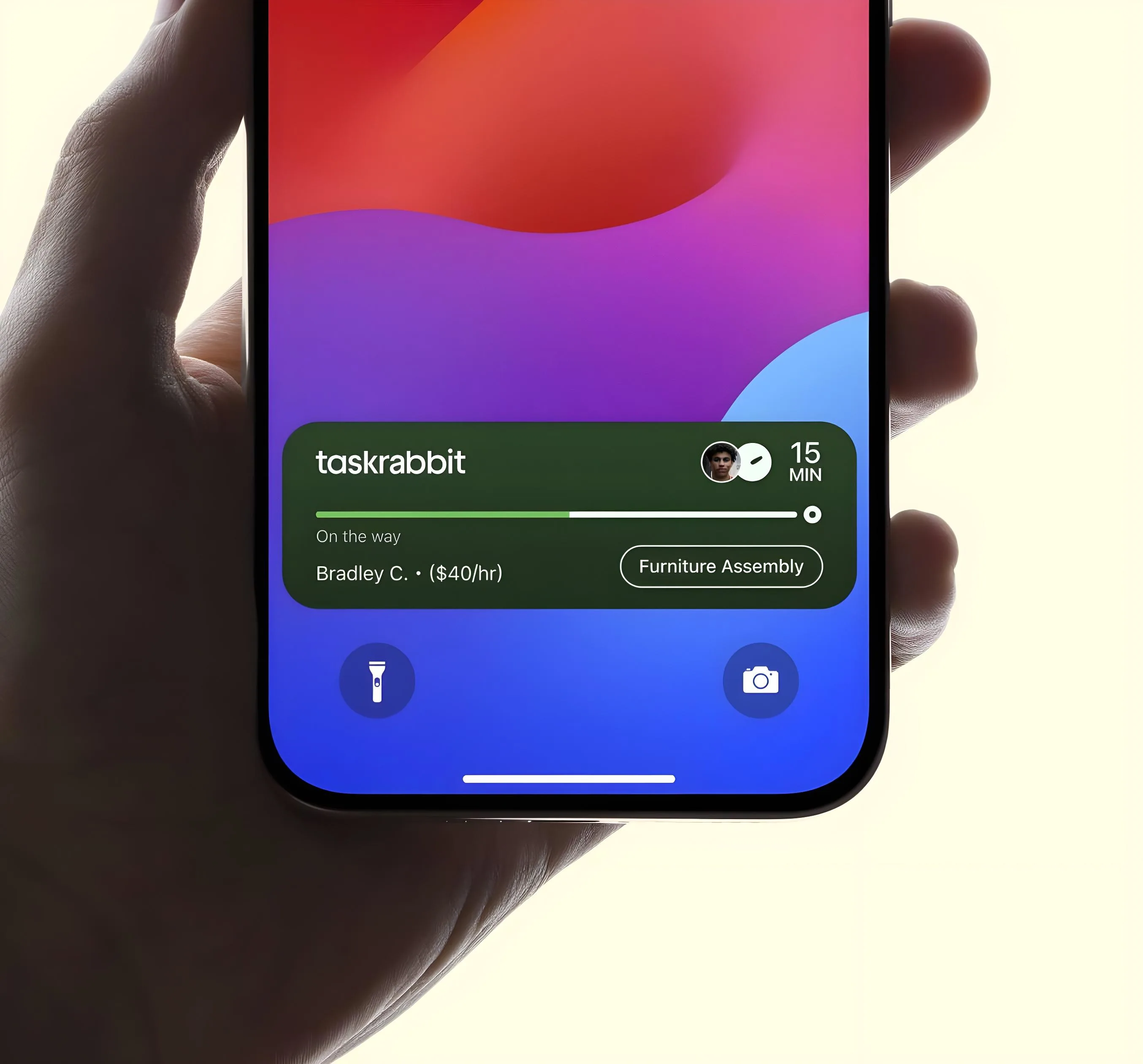
The "final-final" Live Activity design features a dark green interface with essential task information: Tasker profile, estimated arrival time, task type, and progress indicator.
design decisions being evaluated
After 5 design iterations, I conducted A/B testing with 3 participants on three variants with subtle but evident hierarchical differences. While the variations appear minor initially, they addressed key design considerations:
• Brand identity with different color treatments (light/dark)
• Information density (e.g., star ratings vs. numeric ratings)
• Visual contrast for readability



Ultimately, Version 3 was chosen as the optimal design. However, following additional design iteration and feedback, the final solution incorporated more refined typography and contemporary styling. This improved visual clarity and better aligned with my objectives, delivering enhanced precision in the user experience.
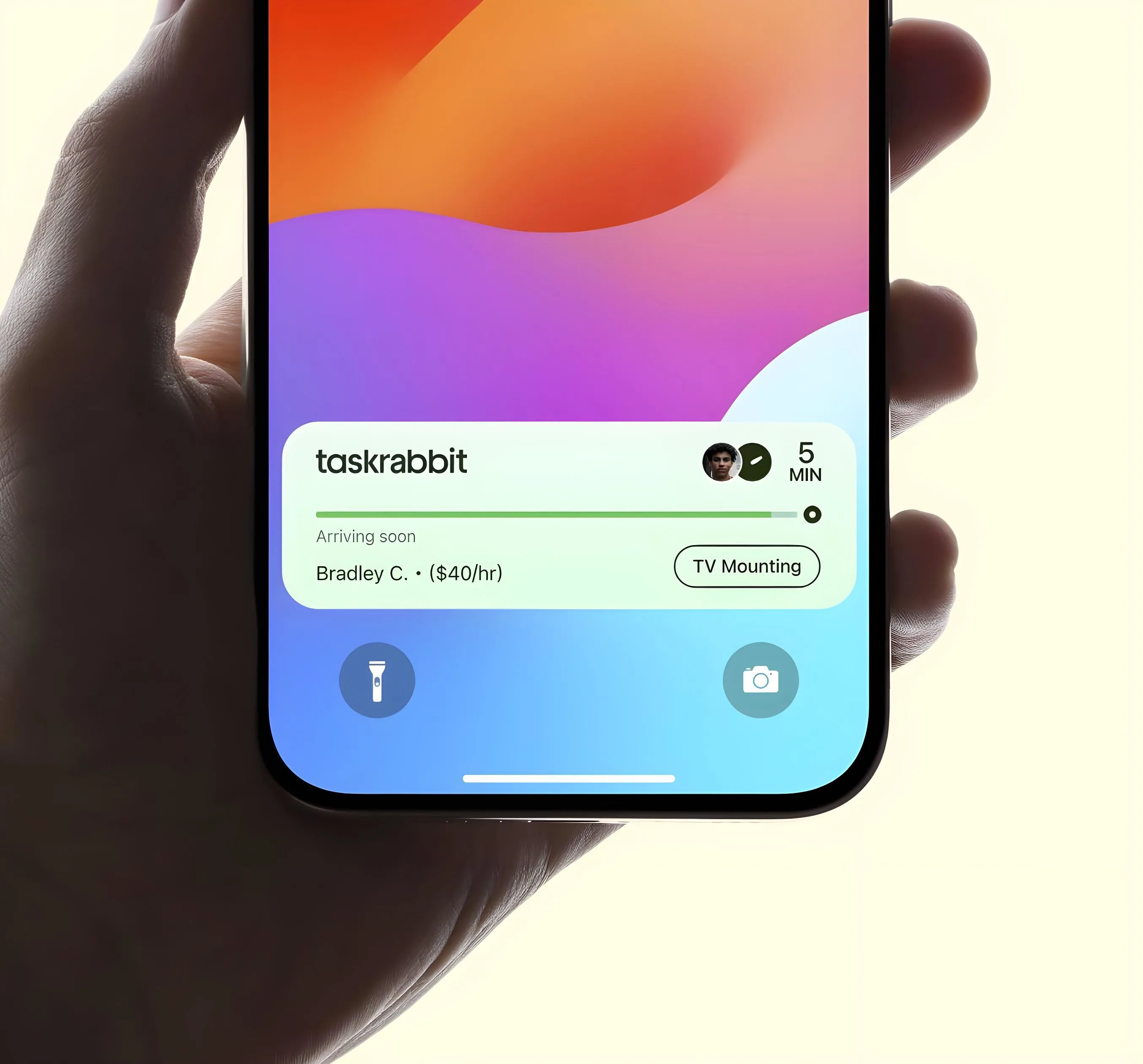
information heirarchy
The restricted vertical space in Live Activities demanded strategic content organization, balancing information with visual clarity:
• TaskRabbit brand colors for immediate recognition (dark and light modes)
• Clean typography hierarchy for quick scanning
• Subtle animations (default for Live Activity) for progress tracking
• Progress indicators showing journey completion/journey delay
• App push notification when the Tasker is a few minutes away
visual design decisions
1. Primary: Tasker ETA (largest, most prominent)
2. Secondary: Job title and Tasker details
3. Tertiary: Task pricing and progression text
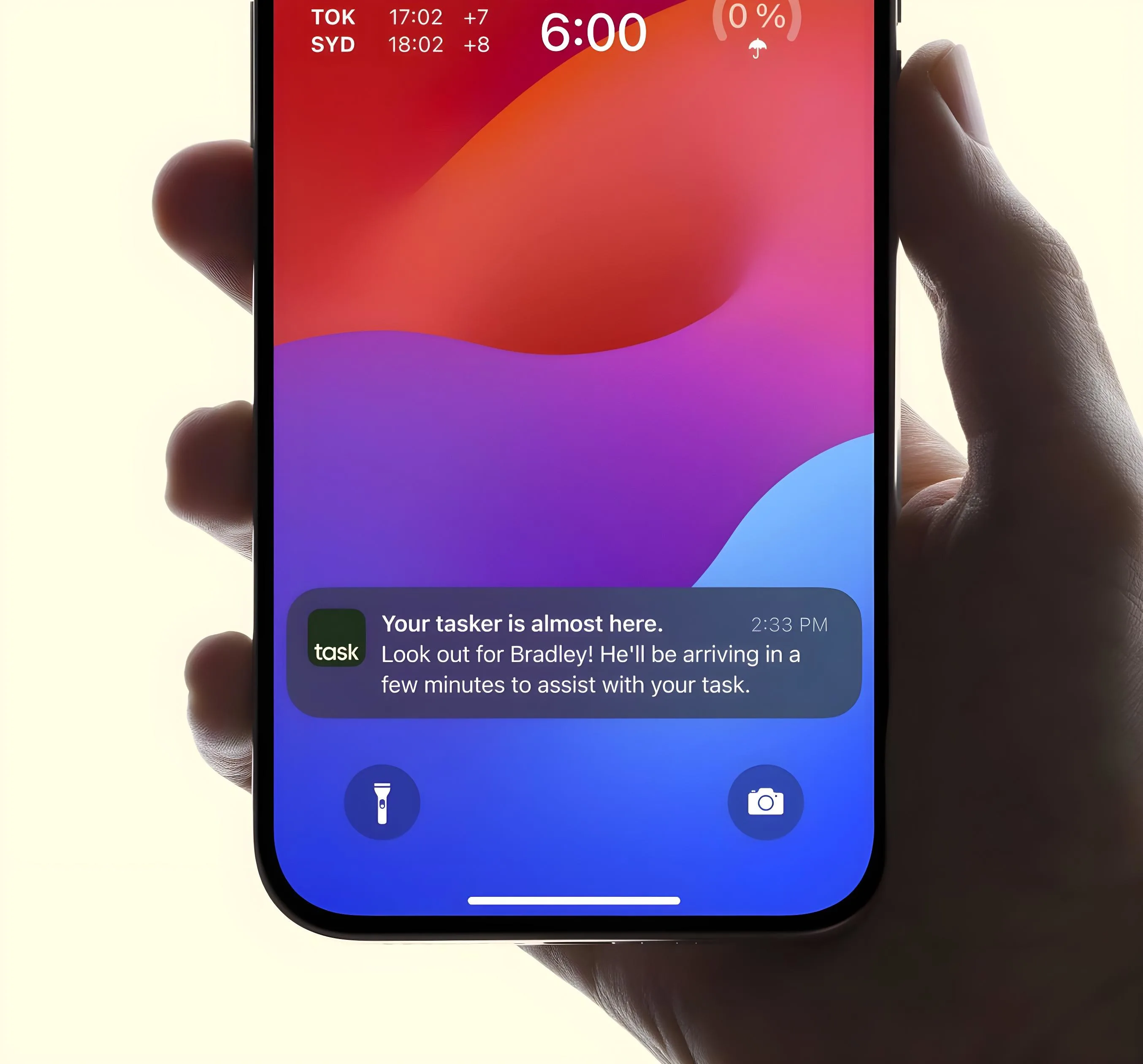
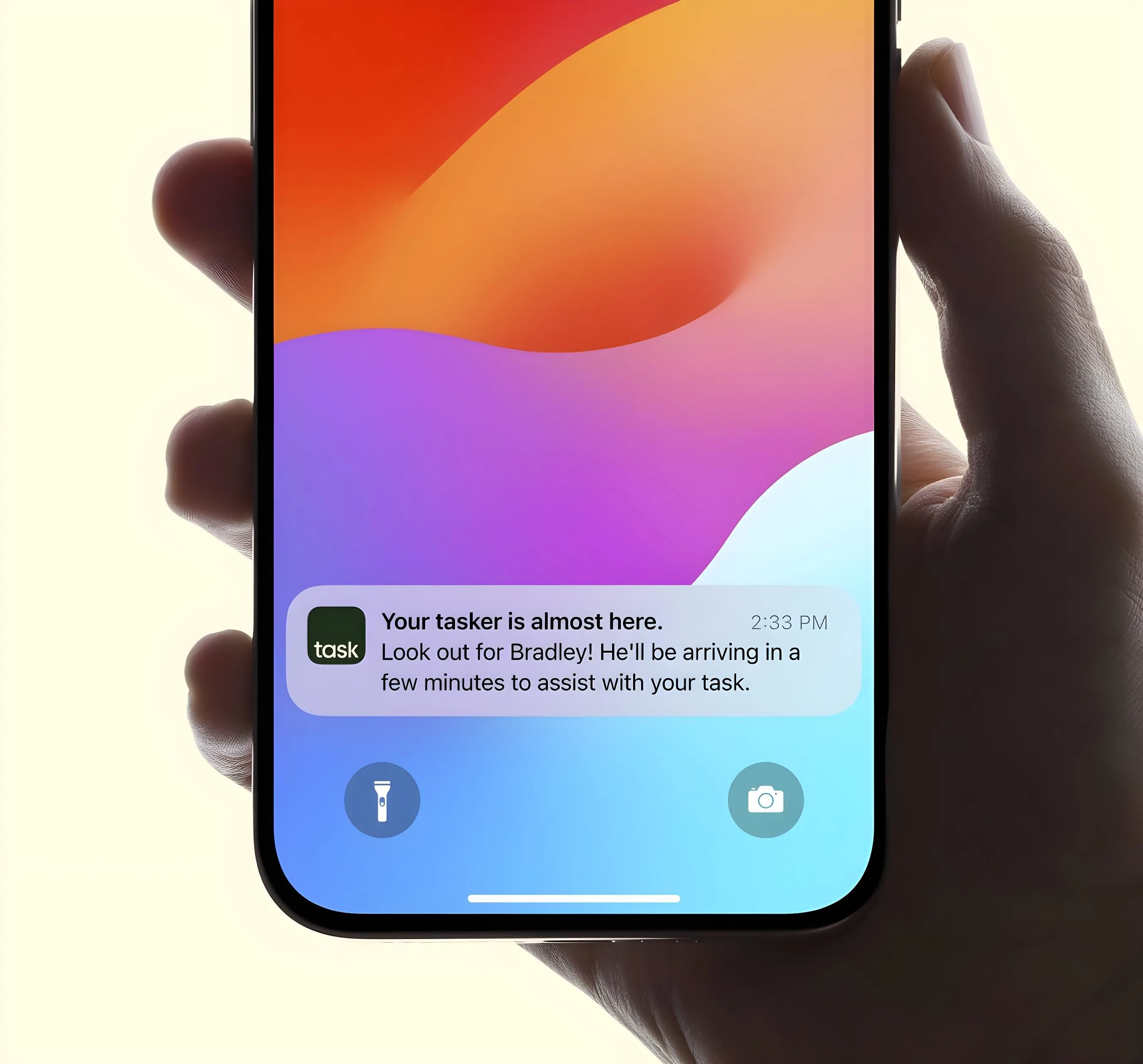
Common Design Patterns for iOS Live Activities
Send a push notification
•
This ensures the user is alerted with a prominent banner, sound, and/or vibration, even if they aren't actively looking at their Lock Screen or Dynamic Island. This push notification can contain the final status and will include an actionable item (e.g., "Meet your tasker”).
End the Live Activity
•
Once the final state is reached and the push notification is sent, the Live Activity should be dismissed from the Lock Screen and Dynamic Island. It might briefly move into a "recent" Live Activity section on the Lock Screen, but its active, real-time updates cease.
Dynamic Island Integration
Dynamic Island Integration: The Live Activity will also appears in the Dynamic Island on compatible iPhone models (iPhone 14 Pro and later), providing a concise view of the Tasker's ETA.
• Compact State: Displays Tasker photo and ETA countdown
• Expanded State: Reveals full task details and location context
• Interaction: Tap to launch TaskRabbit for additional actions

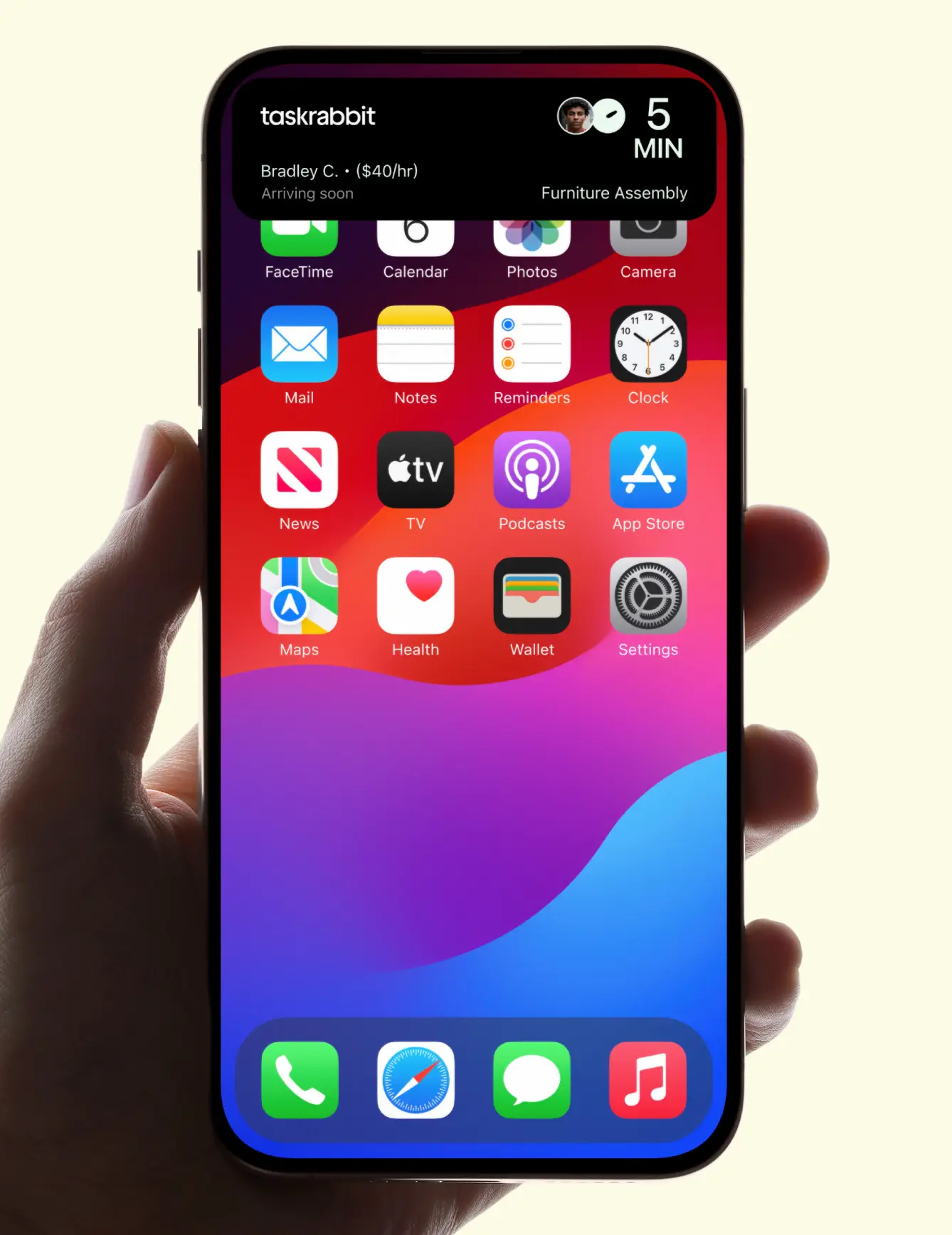
state management
Possible States
• "Departing now" - Tasker en route, ETA calculating
• "On the way" - Tasker en route, >5 minutes passed
• "Arriving soon" - Tasker within 5 minutes of arrival
• "Delayed" - ETA pushed back significantly
In the event the Tasker is delayed, the Live Activity will reflect to indicate it. The progress bar will be read, and an alert icon will replace the timer indicator to the right of the Tasker's photo.
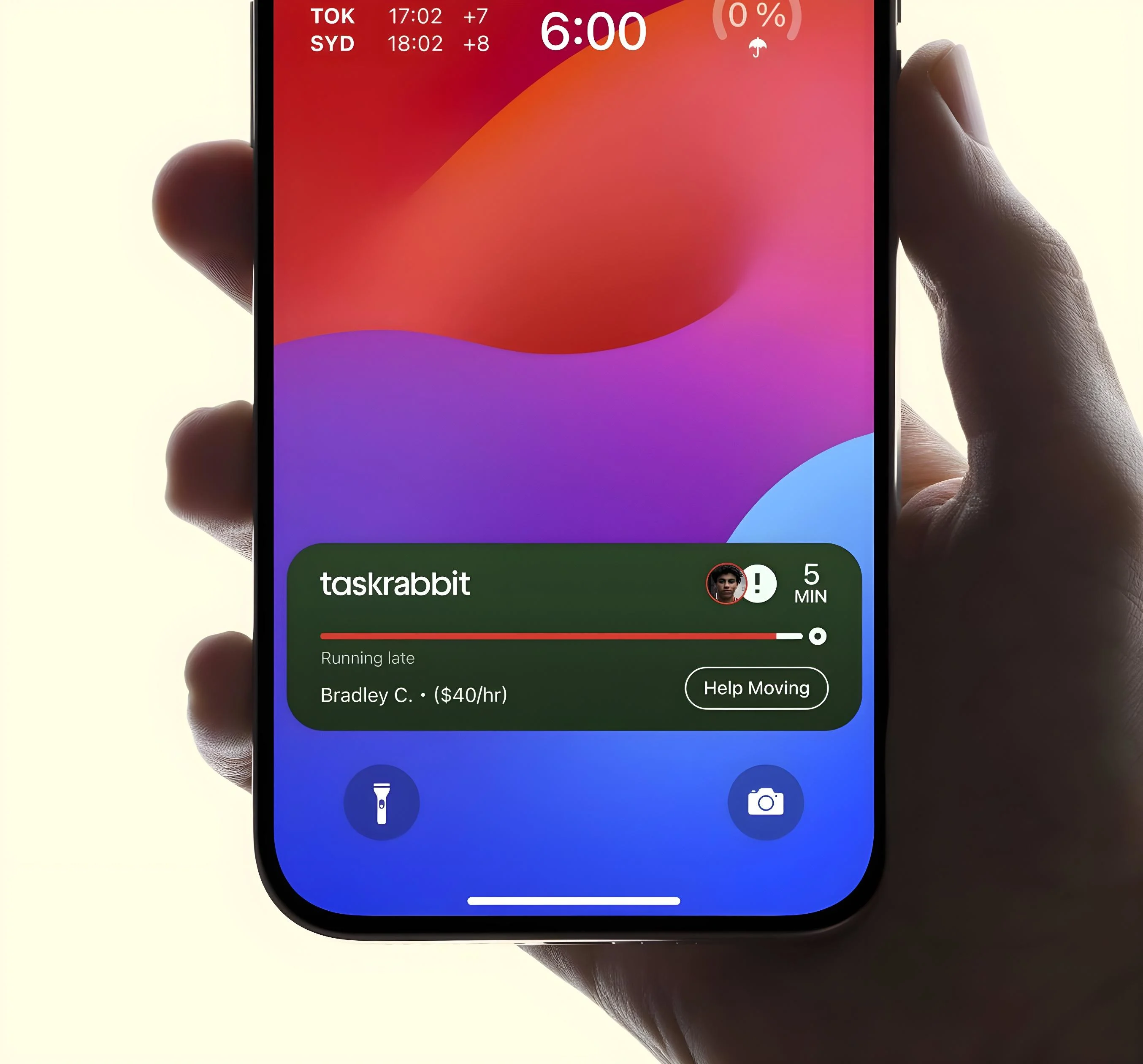
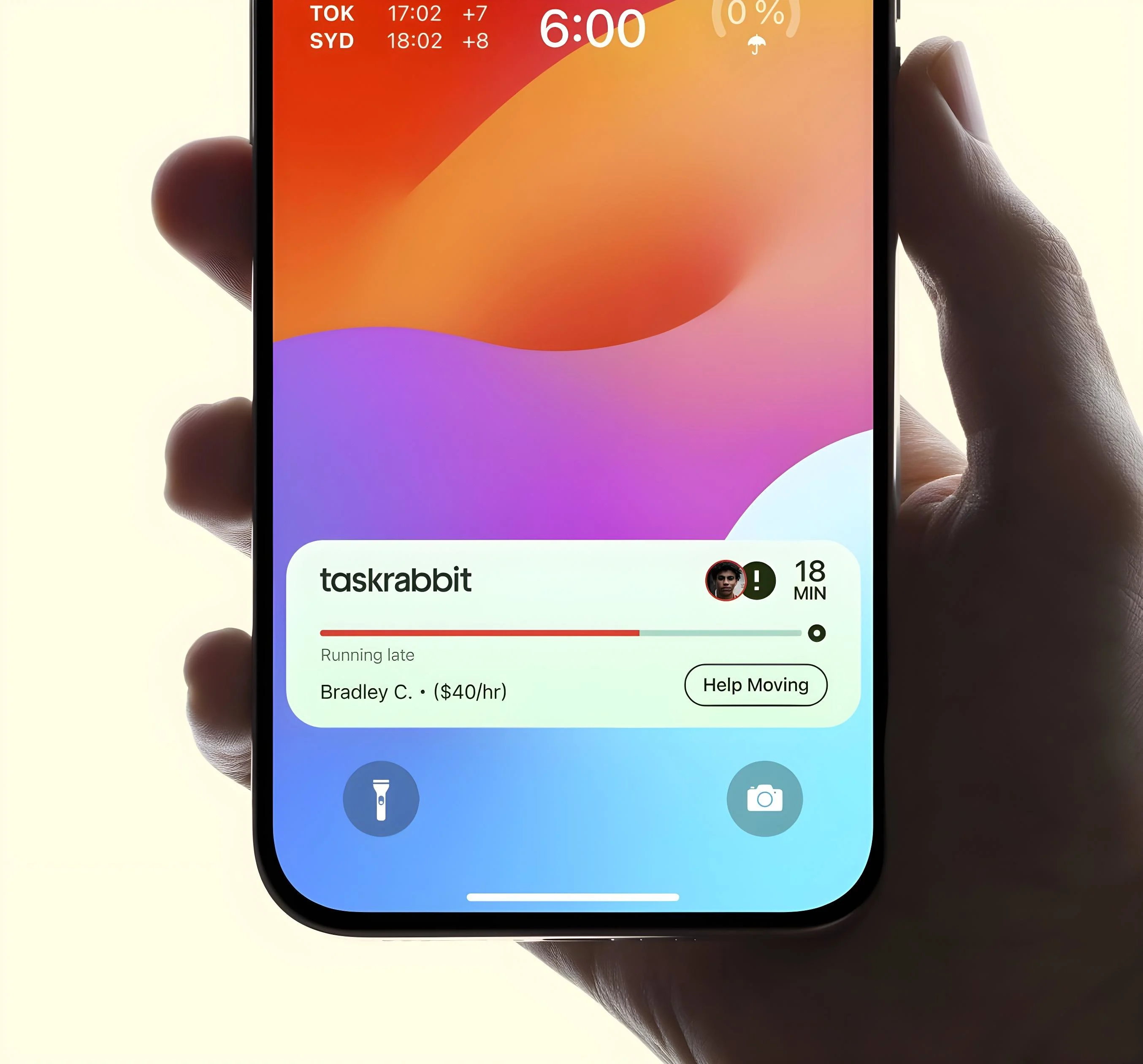
When a Live Activity is Delayed (and Other States)
On the way
•
The Tasker's name and photo will be seen, and the job task type, and a live Estimated Time of Arrival (ETA) with a countdown. There will be a small timer icon and a progress bar indicating the journey has begun. The visual would be concise to fit the Lock Screen or Dynamic Island (in the expanded state).
Arriving soon
•
As the Tasker gets very close (e.g., within 5 minutes), the ETA would update to reflect this. The text might change to "Arriving soon" or simply "Nearby." The visual focus would remain on the countdown, perhaps with a more prominent alert or an animation to indicate imminent arrival for future iterations.
Arrived
•
Once the Tasker reaches the destination, the Live Activity would typically display a clear "Arrived" message. At this point, the Live Activity would generally conclude and disappear from the Lock Screen/Dynamic Island, with a push notification from the app supplementing that the Tasker has arrived at the job site.
Delayed/Running late
•
When the ETA is pushed back significantly, the Live Activity would prominently indicate this. You might see:
• The ETA update to the new, later time.
• A specific "Running late" status or icon (e.g., a small warning triangle or an alert "!" symbol).
• A change in color (e.g., the ETA text turning red) to draw immediate attention.
Design Decisions That Reduce Friction
Why 60-Minute Trigger Window?
This timeframe balances system performance with customer value - longer tracking would increase server load and battery drain, while short windows may not make sense.
The Information Hierarchy Strategy
Working within Live Activities' height constraint forced precise information architecture to reflect the following:
• Primary Details: Tasker ETA (largest, most prominent)
• Secondary Details: Job title and Tasker details
• Tertiary Details: Task pricing and progression text
Platform-Native vs. Custom Solution
Rather than building a custom in-app tracking feature, leveraging iOS Live Activities provided a better solution that works when the phone is locked - exactly when customers need it most.
Projected Business Impact
Primary Success Metrics
• App Session Reduction: A decrease in anxious app-checking during active tasks
• Customer Satisfaction: Improved ratings for ‘communication’ and ‘timeliness’
• Feature Adoption: More iOS 16+ users enabling Live Activity within 30 days
Business Outcomes
• Support Inquiry Reduction: Fewer ‘Where's my Tasker?’ messages and calls
• Competitive Parity: Matching user expectations set by ride-sharing apps
• Customer Retention: Reduced friction in the waiting experience
Technical Validation
• 89% of TaskRabbit's iPhone users have iOS 16+ devices, meaning Live Activities (with Dynamic Island) could immediately impact the majority of the mobile user base.
key learnings
Platform-Native Innovation
Sometimes the best solution isn't building something new - it's leveraging existing platform capabilities in novel ways that solve real user problems.
Constraint-Driven Clarity
Working within Live Activities' display limitations forced cleaner information architecture and more focused UI decisions than a custom solution might have.
Ambient Experiences Win
The most effective features often work passively in the background, providing value without requiring active user engagement - no texting Taskers.
Future Opportunities
This design demonstrates how thoughtful platform integration can remedy customer anxiety while reducing operational overhead - turning a probable pain point into a competitive advantage.
With the foundation established, future iterations could explore:
• Task-specific pre-arrival messages ("Secure pets for dog walking")
• Custom Dynamic Island iconography for different service categories
